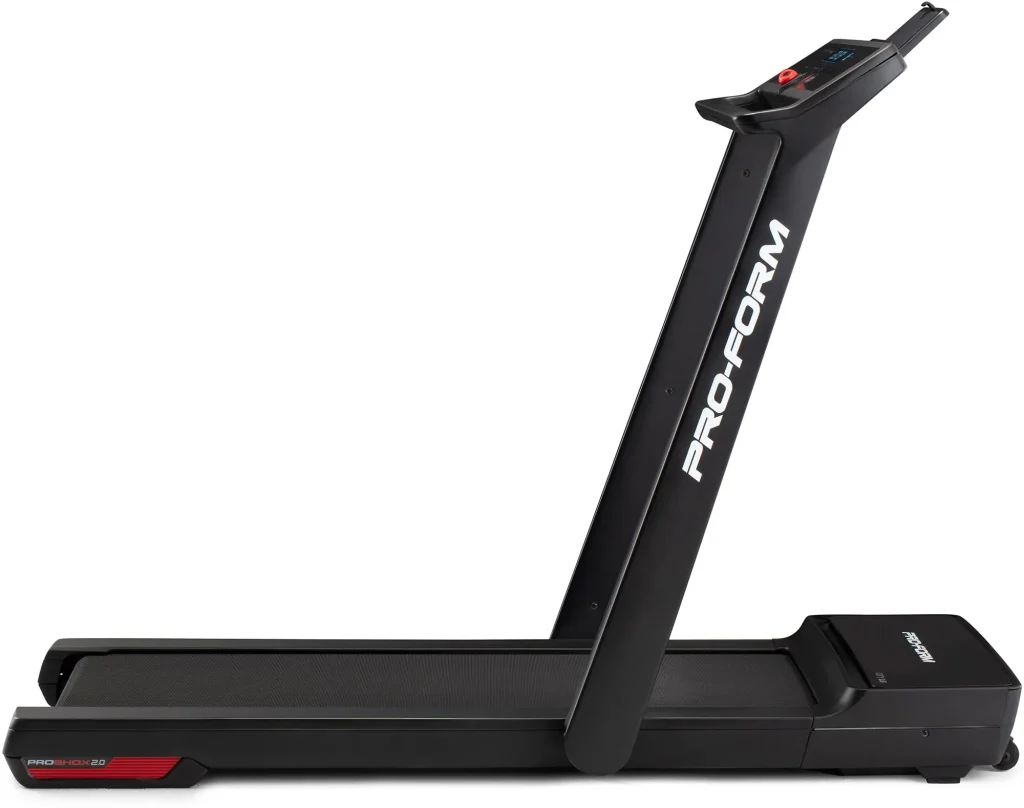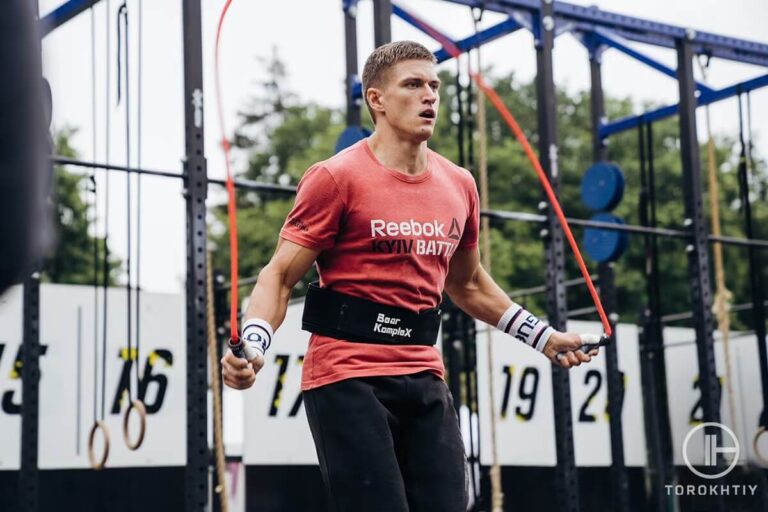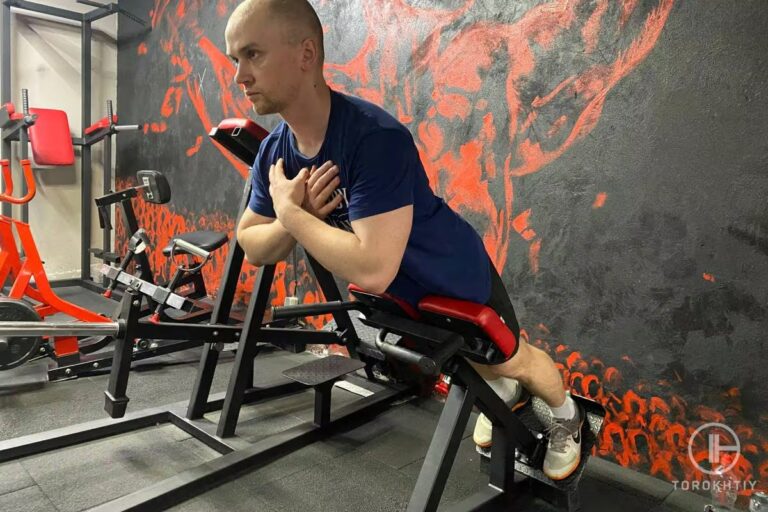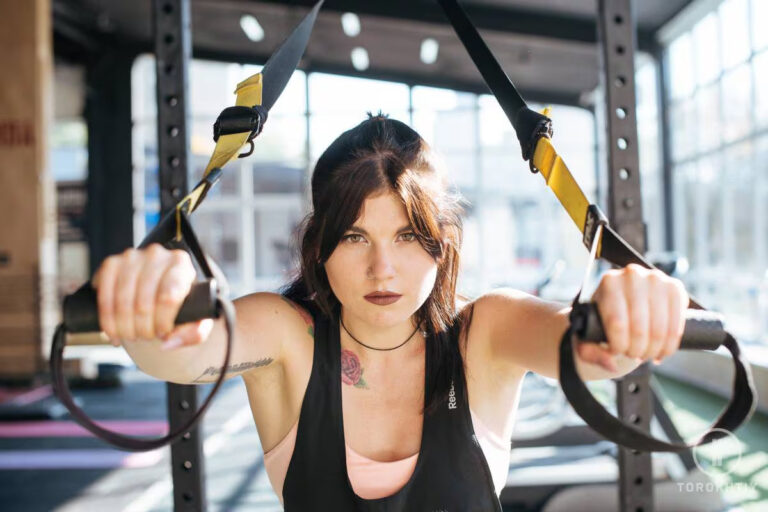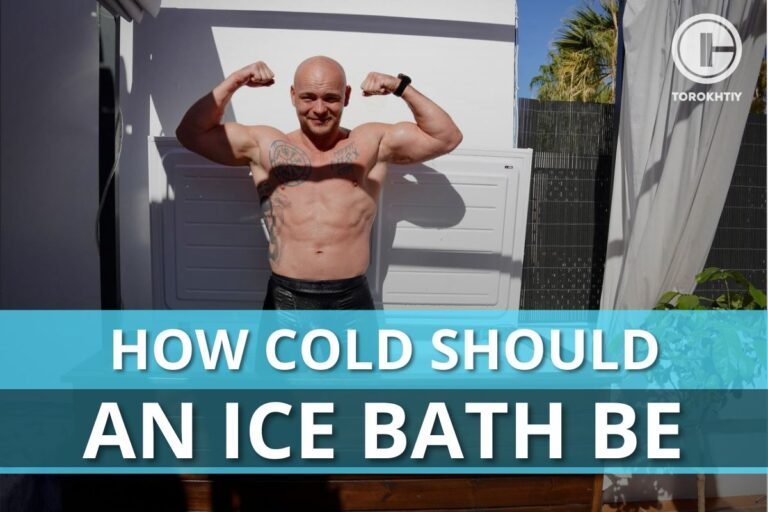Beginner Treadmill Workout: 7 Amazing Tips To Get You Going!
If you’re new to treadmills, I’m assuming you’re wondering what exactly you can do with it. How should you warm up, what workout programs you could do, how can you be careful not to exhaust yourself… Well, a beginner treadmill workout is the way to start!
I always advise starting slow before you up the level of intensity. The treadmill can be your best friend if you know how to approach the workouts correctly.
Lucky for you, I have a bunch of tips and instructions to share with you. Everything from setting the treadmill up, to what to do on it, how to start running on a treadmill, and even what treadmill to choose – you name it, I have it!
Lace up and let’s hop right on the treadmill and see exactly what you could do with it!
What is a beginner treadmill workout? Simply put – it’s a great way to start for people who are new to treadmills. There’s usually a lot of walking and jogging included. Everything that you need to more easily start running on a treadmill if you’re a beginner.
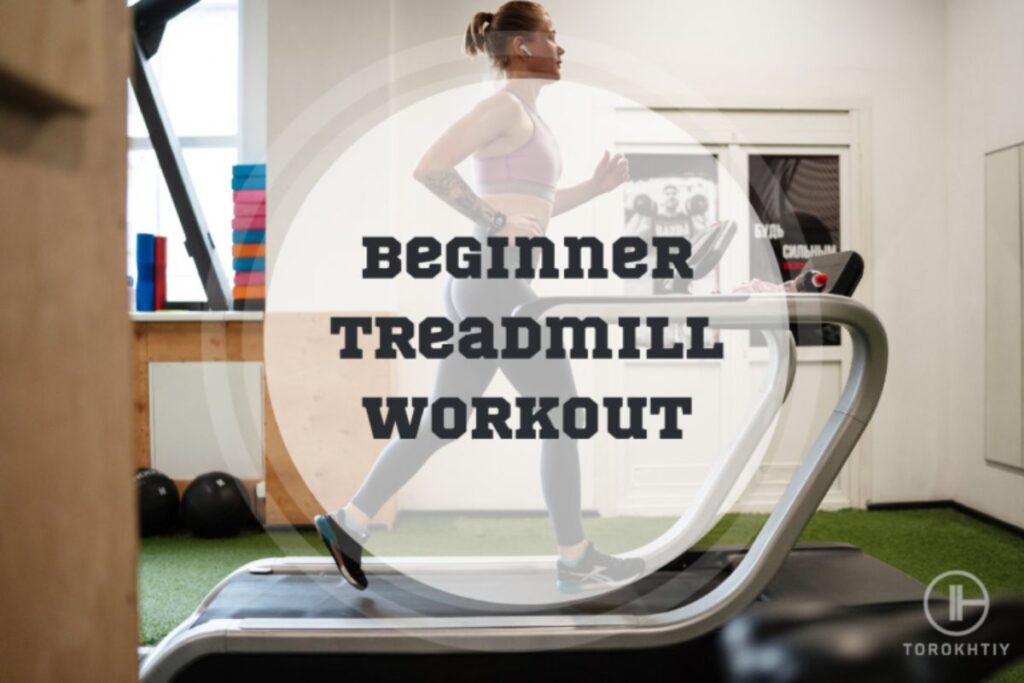
Overview of a Beginner Treadmill Workout
In my experience, a lot of people see a treadmill and want to start running right away. It doesn’t matter that they’ve never stepped on it; running is the way to go.
Running is great. That’s just how it is – you get excellent cardio, and improved mental well-being. But the problem is, if you don’t have experience with running on a treadmill, it’s not the best way to start.
What makes a beginner treadmill routine so good is just as the name would suggest – it’s for beginners. You’ll be starting off slow, without the risk of injuring or exhausting yourself.
And a treadmill is a great way to start. Regardless of working out in your living room or at a gym, a treadmill means your environment is beginner friendly. Think about it – there’s no incline if you don’t want it to be, and there’s no rain, wind, or uneven terrain… It’s the ideal way to learn.
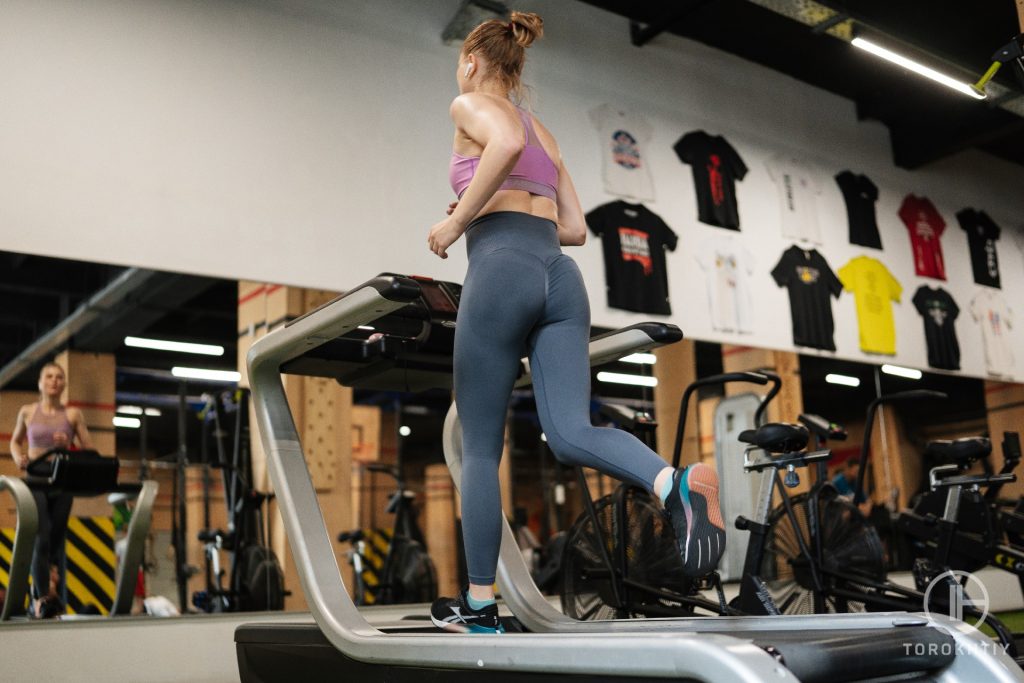
1. Walking Workout Program for Beginners
Walking is absolutely perfect to kick things off with because it’s easy, low-impact, and you can easily include it into your daily routine.
I have a 10-week beginner treadmill workout plan so you can be sure you’re starting off at the right pace and progressing as you go along.
| Week | Warm-up | Main Walk | Cool Down |
|---|---|---|---|
| 1 | 5 mins (at natural pace) | 10 mins (slightly faster) | 5 min (slow walk) |
| 2 | 5 mins (at natural pace) | 15 mins (slightly faster) | 5 min (slow walk) |
| 3 | 5 mins (at natural pace) | 20 mins (slightly faster) | 5 min (slow walk) |
| 4 | 5 mins (at natural pace) | 25 mins (slightly faster) | 5 min (slow walk) |
| 5 | 5 mins (at natural pace) | 30 mins (slightly faster) | 5 min (slow walk) |
| 6 | 5 mins (at natural pace) | 35 mins (slightly faster) | 5 min (slow walk) |
| 7 | 5 mins (at natural pace) | 40 mins (slightly faster) | 5 min (slow walk) |
| 8 | 5 mins (at natural pace) | 45 mins (slightly faster) | 5 min (slow walk) |
| 9 | 5 mins (at natural pace) | 50 mins (slightly faster) | 5 min (slow walk) |
| 10 | 5 mins (at natural pace) | 60 mins (slightly faster) | 5 min (slow walk) |
Regarding walking speed – a speed of up to 3.7 mph is considered walking speed. So you’ll have to decide on what works for you when you read the term ‘slightly faster’. I suggest trying 3.5 mph to see how it feels. If you feel that it is too challenging, then decrease the speed and try again.
For week 1, take a brisk 5-minute walk at whatever pace feels natural to you. Then, up your pace a bit for 10 minutes. After 10 minutes, slow down and cool off with another 5-minute walk. That was easy, right?
For week 2, your warm-up is going to be the same – you’ll take a 5-minute walk. Then, you will be walking at a slightly higher pace for 15 minutes, and then you’ll cool down for 5 minutes with a slow walk.
Week 3 brings about whole 30 minutes of walking! You’ll warm up for 5 minutes, then walk for 20 minutes at a higher pace, then cool down for 5 minutes.
In week 4, we’re going to up the duration even more! The warm-up and cool-down always stay the same – 5 minutes of slow walking. But now, you’re going to be walking at a bit of a higher pace for 25 minutes.
As each week begins, add 5 more minutes to your workout. At week 10, you should be walking at a higher pace for 60 minutes, with a warm-up and cool-down lasting 5 minutes each.
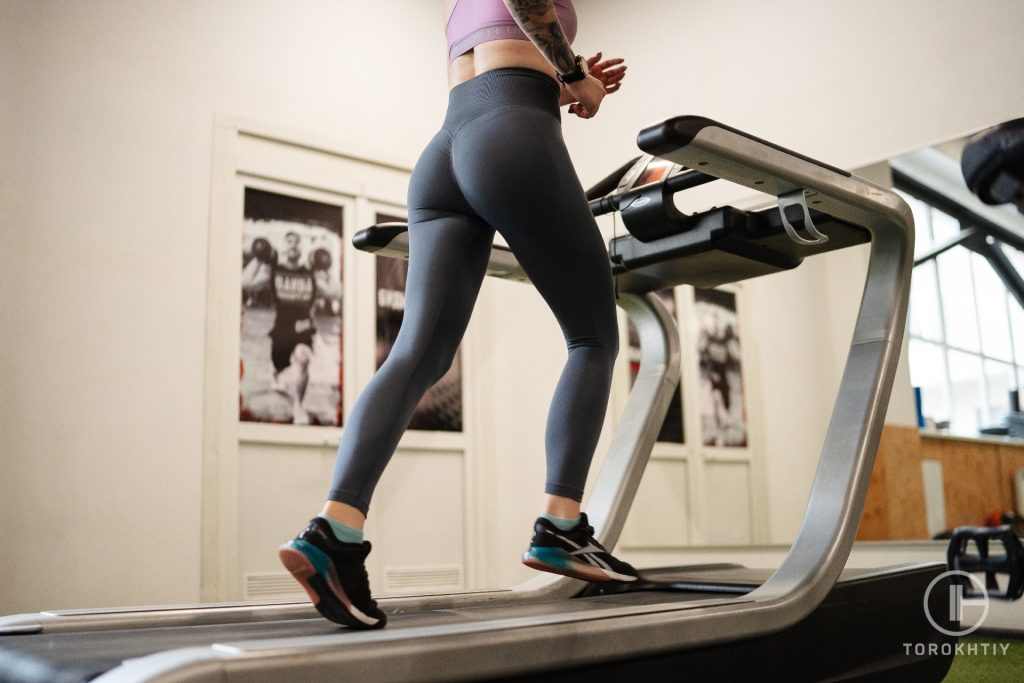
2. Running Workout Program for Beginners
If you’re a beginner and do not want to spend your time walking (although that time is never really a waste – walking on a treadmill is very useful), I have a 8-week (2-month) treadmill workout for beginners (a running program) for you.
Running is amazing because it boosts cardiovascular fitness, burns calories, and improves your overall well-being. It makes sense that you’re so anxious to start.
| Week | Warm-up | Main Walk | Cool Down |
|---|---|---|---|
| 1 | 5 mins (walk) | 1 min run + 1.5 min walk (repeat until you reach a total of 20 mins) | 5 min (slow walk) |
| 2 | 5 mins (walk) | 2 min run + 1.5 min walk (repeat until you reach a total of 20 mins) | 5 min (slow walk) |
| 3 | 5 mins (walk) | 3 min run + 1.5 min walk (repeat until you reach a total of 20 mins) | 5 min (slow walk) |
| 4 | 5 mins (walk) | 8 min run + 2 min walk (repeat until you reach a total of 20 mins) | 5 min (slow walk) |
| 5 | 5 mins (walk) | 10 min run + 2 min walk (repeat until you reach a total of 25 mins) | 5 min (slow walk) |
| 6 | 5 mins (walk) | 15 min run + 2 min walk (repeat until you reach a total of 30 mins) | 5 min (slow walk) |
| 7 | 5 mins (walk) | 20 min run + 2 min walk (repeat until you reach a total of 35 mins) | 5 min (slow walk) |
| 8 | 5 mins (walk) | 20 min run (run until you reach a total of 20 mins; no walking) | 5 min (slow walk) |
Regarding running speed – a speed from 5-6.2 mph is considered light running, while a speed of 6.2-8.1 mph is considered dedicated running. It is up to you to decide which pace you’ll choose. I suggest starting with the minimum light running speed to start things off and then checking to see how your body reacts. If there is little to no challenge, consider increasing your running speed. For walking, any speed up to 3.7 mph is considered ‘walking’.
For week 1, you’ll be taking a walk for 5 minutes to warm up. Then, run for 1 minute and then walk for 1.5 minutes. Repeat this interval until you reach 20 minutes. After the 20 minutes have passed, take a nice, slow walk for 5 minutes to cool down.
Week 2 will also start with a nice 5-minute walk because we can never get enough walking. After your walk, run for 2 minutes and then walk for a minute and a half. Do this for 20 minutes, then cool down by walking for 5 minutes.
Week 3 starts with, you guessed it – a 5-minute walk. When you’re all warmed up, run for 3 minutes, and after, walk for a minute and a half. Keep going for 20 minutes, and then walk for 5 minutes to cool down.
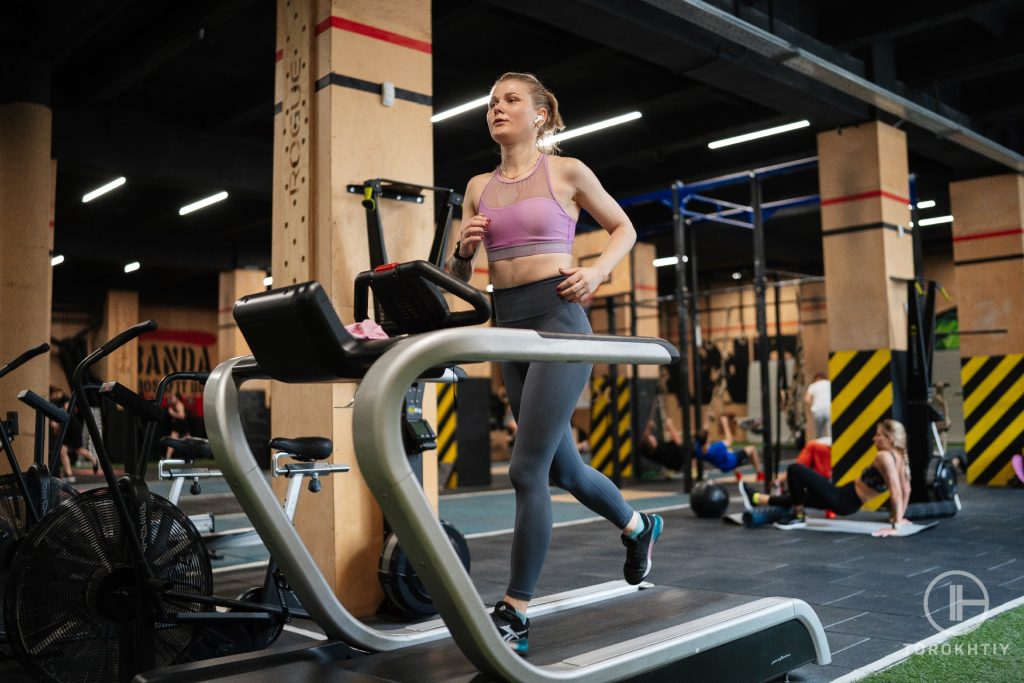
Week 4 is starting off with a walk, too. 5 minutes, per usual. Run for 8 minutes, then walk for 2. Repeat this for 20 minutes and then cool down with a walk – 5 minutes, of course.
Week 5 means business, and you’ll be running a lot more. After your usual 5-minute walk for warm-up, run for whole 10 minutes. After the 10 minutes have passed, take a break by walking for 2 minutes. Repeat this for 25 minutes, and then cool down with a walk.
You get the idea now, right? As you finish with week 5, each following week should start and end with a 5-minute walk. What you’ll be changing is the workout itself. Tack on 5 minutes of running each week (broken up by 2 minutes of walking) until you reach week 8.
For week 8, you’ll be running without taking the 2-minute walk between running intervals. Warm up with a walk for 5 minutes, then run for 20 minutes, and then cool down with a walk for 5 minutes. Easy-peasy, lemon squeezy!
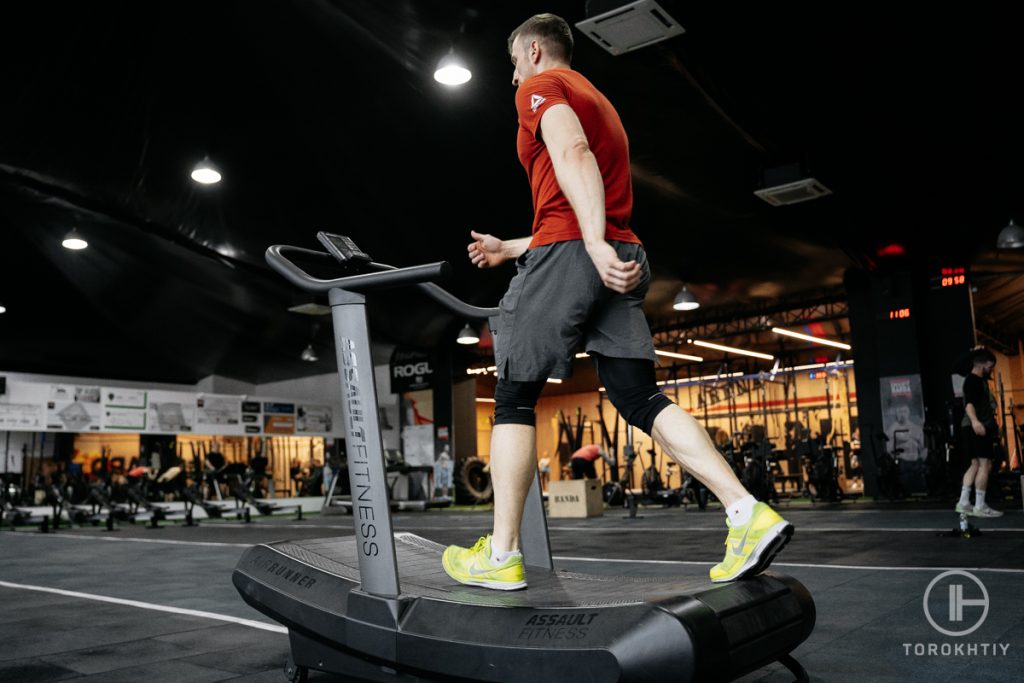
7 Tips for Beginners on a Treadmill
The act of running might seem like a malevolent force to some beginners. But it really isn’t. Your body still hasn’t adapted to running yet, and you’re conflicted when being out of breath. Luckily, with these seven tips I’ve prepared for you, you’ll more effortlessly be able to ease into running from the get-go!
1. Setting Up the Treadmill
You’ll need to become friends with your treadmill’s controls and features. Adjust the speed to what’s comfortable for you and what your fitness level allows. No need to rush!
If you want to intensify your workout, you can increase the incline a bit. Don’t go wild and increase it to 15% right away. Start with a lower incline and then increase it as you get more used to it.
2. Safety Precautions and Warm-Up Exercises
Your treadmill has safety features for a reason – use them. Emergency stop button and safety clip are super important and can mean a difference between you getting injured or not.
A warm-up is just as important. Before you start your workout, always warm up your muscles first. Dynamic stretches or a brisk 5-minute walk are great for warming up.
3. Choosing the Right Workout Attire and Footwear
You want something comfortable and breathable. The best you can go for are running-specific clothes. These are light and designed to move with your body. Ideally, you want the clothes/footwear to be breathable.
You’ll be sweating a lot. So avoid cotton. Once soaked with sweat, it gets heavy and hinders you from performing at your max capacity.
If it’s cold outside, don’t forget to layer your clothes. Get multiple thin layers. But be sure to avoid bulky and fleecy clothing.
Running shoes are even more important than your clothes. A proper (functional) pair of running shoes will make all the difference, so invest in a good quality pair. You want enough support and cushioning to keep your foot stable. Basically, you want running shoes that are perfect for the exercise you’re doing and ones that fit perfectly to your body (your foot).
An extra hint is to avoid chafing. To prevent chafing and reduce friction, create a layer between your skin and your running clothes. You can do that by using Vaseline or Talcum Powder, or use a pair of tight seamless shorts underneath your running shorts.
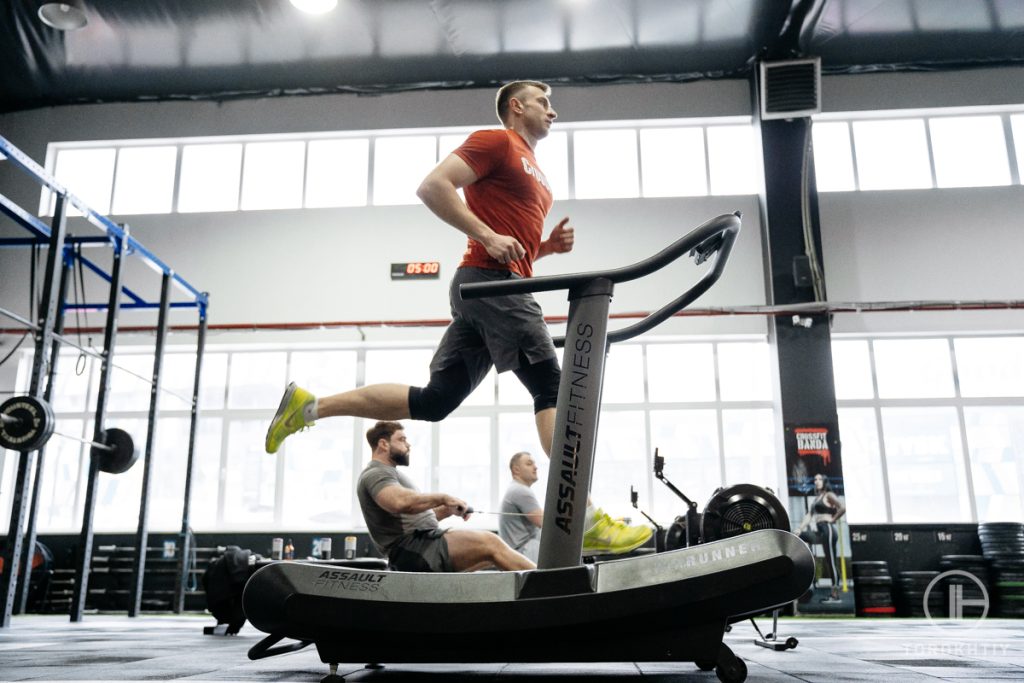
4. Proper Hydration During Workouts
Don’t put yourself at risk of dehydration – keep a water bottle near you and take a sip whenever you can. But the problem is, you can’t really run around with a gallon of water strapped around your waist. And it is better to avoid a lot of water before you start running either, as it can affect your overall comfort and convenience while running.
By drinking water, you are lowering the amount of sodium in your blood. And if the level of sodium gets abnormally low, you start suffering from a condition called hyponatremia. The symptoms include nausea, confusion, seizures, and even coma, in some rare cases. So, yeah. Please avoid that.
It is best to do the following. Drink plenty of water every day. The daily water intake for men is around a gallon per day and around 0.7 gallons for women.
Other than that, take about 17-20 fluid ounces of water two to three hours before the run. Add another 6.5-10 fl. oz. about 10-20 mins before the actual running starts.
If you’re running for less than an hour, you can get away with not drinking water during the run at all. But if you plan on running longer than that(or if it is a hot day), then I suggest drinking around 5-10 fluid ounces of water every 20 minutes during the run. The average water bottle holds around 16-32 fl. oz. (that is half a liter to a liter if you live outside the US). I suggest getting (at least) a 16-ounce bottle with you.
And, of course, after the run, you need to replace the fluids you lost during the run. But you don’t want to overhydrate. To properly rehydrate, it is best advised to drink enough water to keep the body mass loss to less than 2 percent. So, for example, if you’re a 150-pound person, drink about 3 pounds of water, which converts to 46 fl. oz.
Remember that you don’t want to feel uncomfortable by drinking too much water all at once.
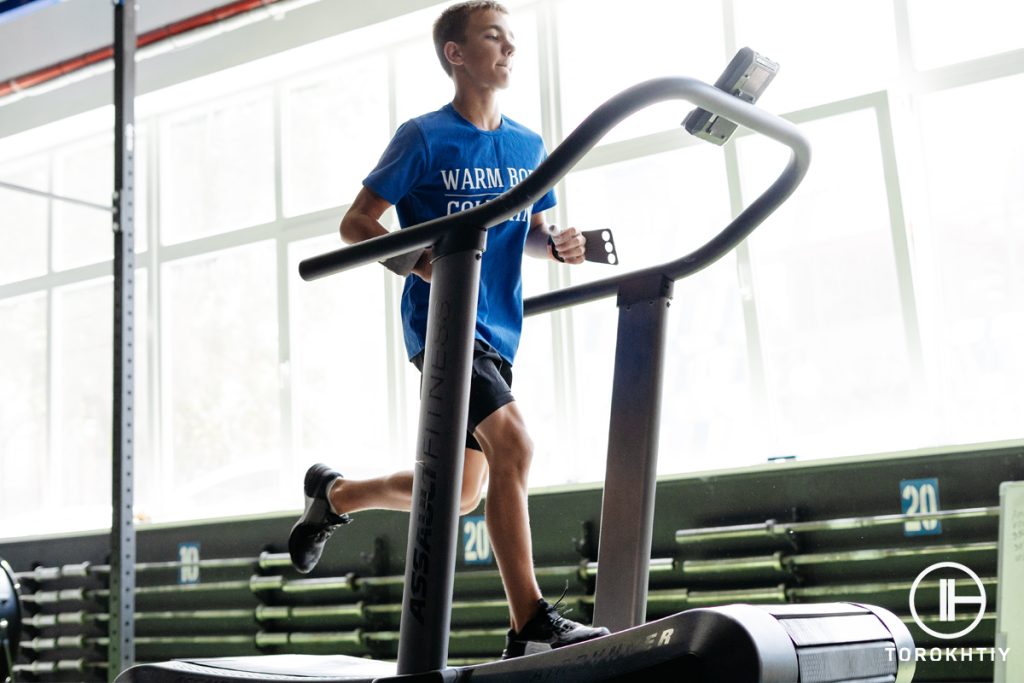
5. Listening to Your Body and Avoiding Overexertion
If you’re a beginner, it’s fine if you can’t do something someone advanced can – give yourself enough time to progress step-by-step. If you feel dizzy or lightheaded during a workout, take a break. Drink some water and adjust your workout, or even stop altogether. Remember that this is not a competition.
6. Incorporating Cross-Training and Rest Days
If you limit yourself to just the treadmill, you’ll soon get bored, and we don’t want that. Strength training or yoga is great to break it up and to keep things interesting.
Of course, you need to give your body some rest, too. Take 2 or 3 days a week to be lazy, rest and recover from your workouts.
7. Choose the Right Treadmill
Take your time to read reviews online, or you can even ask a trainer at your local gym for their opinion. Treadmills have different features, programs, and motor power. Some have inclines, others don’t. It all comes down to the goals that you want to reach. If you aren’t sure about your goals or what you’re trying to achieve – make sure to consult/ask a trainer or experienced runner for advice.
This way you are making sure you’re investing in something that will actually be of use.
Treadmill We Recommend – ProForm City L6
As long as we’re on the topic of reviews, there is something exquisite to recommend. This one has everything you want your new treadmill to have.
This one was practically made for home gyms because it’s foldable so you can just tuck it in your closet after your workout. You know… If you don’t want it staring at you from across the room, remind you to get off that couch and work out because today is not a rest day.
The machine is quite compact but large enough with dimensions 29 inches in width, 70.25 inches in length, and 44.5 inches in height. And the running belt is 17.5 inches in width and 45 inches in length!
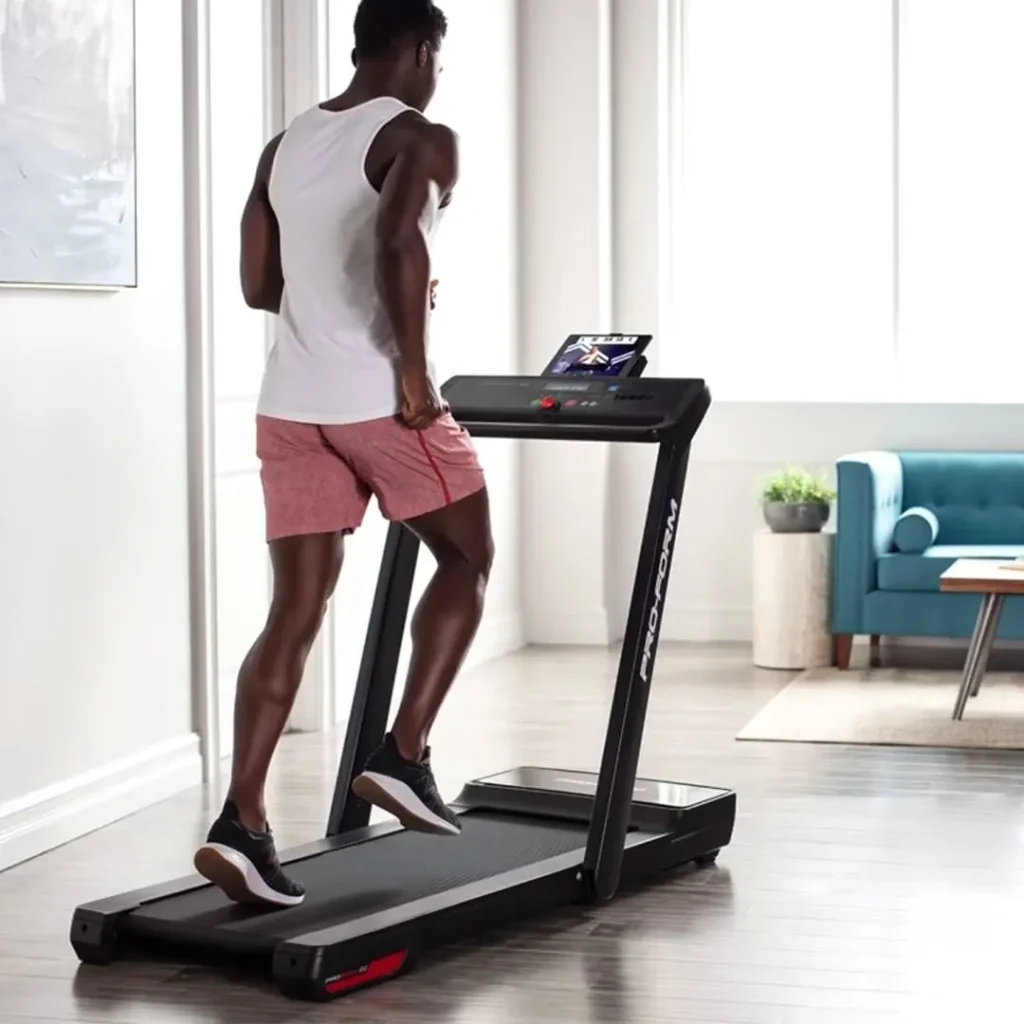
The surface you’re running on is another great thing about it because it’s low impact. This means that it’s nice to your hips, knees, and ankles, and it’s good to use even if you have issues with your joints.
The speed of 0-8 MPH (provided by its 1.6 hp motor) means it can be a perfect treadmill exercise for beginners, but it will also kick your butt with a more intense workout once you’re ready.
The screen is just too small, and there’s no way around it. At only 5’’, I feel like I really need to focus on what I’m looking at it. And the thing is, while working out, you want to be able to just glance over and see the information you need. The screen is still functional, though, it might be too small for someone.
Positives:
Could be better:
- Small screen
FAQ
How Long Should a Beginner Work Out on a Treadmill?
A beginner should work out for about 20 to 30 minutes when they start. It’s also important to take breaks when you feel that you need to and drink plenty of water during the workout.
What Should Beginners Do on a Treadmill?
A beginner should start with a combination of walking and (light) jogging before running. Walking is a fantastic start because it is low-impact, great for your joints, and you don’t really have a lot of risk of injuring yourself.
Is 30 Minutes on a Treadmill Enough Exercise?
Yes! 30 minutes on a treadmill can be a great workout with lots of health benefits. 30 minutes on a treadmill will torch calories and improve your cardiovascular health.
Conclusion
That was A LOT of walking and running! You should have a pretty good idea on how to start learning to run on a treadmill, how to take walks on it, and you even have a recommended treadmill to look into!
Is there anything you’d like to add? Do you prefer walking or running on a treadmill? Is treadmill running for beginners something you think will work for you, or will you stick to walks? Have you seen results from using a treadmill, and if you have, what are they?
I’ll be hopping on my treadmill now: I’ve been sitting for a while writing this article for you, and I already need to stretch my legs. Feel free to leave any thoughts, comments, or recommendations, and let’s talk. Until the next one!
Also read:
- How to Adjust Treadmill Belt
- What Muscles Does Treadmill Work
- How to Lose Weight on a Treadmill
- How Much Is a Mile on a Treadmill
- Benefits of Treadmill
- Stairmaster vs Treadmill
- How to Maintain a Treadmill
- Best Folding Treadmill
- Best Under Desk Treadmill
- Best Walking Shoes for Treadmill
References:
- J Appl Gerontol, Low-Intensity Walking Activity is Associated with Better Health (NCBI, 2013 Dec 11) https://www.ncbi.nlm.nih.gov/pmc/articles/PMC4053519/
- What is dynamic stretching and how to do it? (Medical News Today, 2021 January 20) https://www.medicalnewstoday.com/articles/dynamic-stretching#summary
- Kieran O’Sullivan, The effect of warm-up, static stretching and dynamic stretching on hamstring flexibility in previously injured subjects (BioMedCentral, 2009 April 16) https://bmcmusculoskeletdisord.biomedcentral.com/articles/10.1186/1471-2474-10-37
- J Hum Kinet, Hydration to Maximize Performance and Recovery (NCBI, 2021 Jul) https://www.ncbi.nlm.nih.gov/pmc/articles/PMC8336541/
- BMC Public Health, Public knowledge of dehydration and fluid intake practices: variation by participants’ characteristics (NCBI, 2018 Dec 5) https://www.ncbi.nlm.nih.gov/pmc/articles/PMC6282244/
- Douglas J. Casa, Influence of Hydration on Physiological Function and Performance During Trail Running in the Heat (JAT, 2010 March 01) https://meridian.allenpress.com/jat/article/45/2/147/111103/Influence-of-Hydration-on-Physiological-Function
Why Trust Us?
With over 20 years in Olympic Weightlifting, our team does its best to provide the audience with ultimate support and meet the needs and requirements of advanced athletes and professional lifters, as well as people who strive to open new opportunities and develop their physical capabilities with us.
By trusting the recommendations of our certified experts in coaching, nutrition, dietology, and sports training programming, as well as scientific consultants, and physiotherapists, we provide you with thorough, well-considered, and scientifically proven content. All the information given in the articles concerning workout programming, separate exercises, and athletic performance, in general, is based on verified data. We ensure that you can rely on our professionals’ pieces of advice and recommendations that can be treated as personalized ones which will benefit you and fully meet your needs.
The product testing process is described in more detail here
Author: Ihor Shymechko
Pro Olympic Weightlifter, Coach
Best Results: Snatch – 208 kg,
C&J – 240 kg
Ihor has been a professional weightlifter since 1996, boasting over two decades of competition experience. His notable achievements include clinching the European Championship in 2009 and securing a silver medal in the 105kg division at the Senior World Championships in 2011. Ihor represented his country in the 2008, 2012, and 2016 Summer Olympics. After retiring from competitive weightlifting, he transitioned to coaching, leveraging his vast experience to guide athletes who now compete on both national and international stages.

